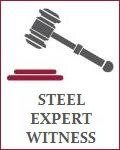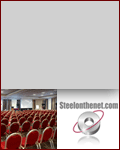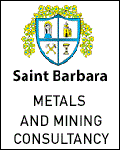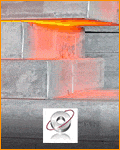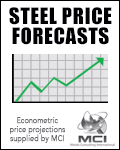Steel Industry Glossary of Terms: P-S.
Technical glossary
| Term | Glossary Explanation |
| PAH | Polycyclic aromatic hydrocarbon. These may be emitted during electric steelmaking to the air, and thus represent a potential health hazard in EAF operations |
| Passivation | Changing of a chemically reactive metal surface to a less reactive state, typically through chemical treatment |
| PCI | Pulverised coal injection - a process increasingly used in blast furnaces, typically offering substantial economic benefits through greater use of coal and proportionately less use of metallurgical coke |
| Pickling | Removal of mill scale by mechanical and chemical means |
| Pig iron | A key intermediate material in the integrated (converter-based) steelmaking process, pig iron is the product of smelting iron ore, coke and limestone in a blast furnace. Merchant pig iron is sometimes used as as substitute for scrap in EAF steelmaking, when there is a need to control residuals |
| PPGI | Pre-painted galvanised iron, a common term for pre-painted hot dip galvanised steel - also known as organic coated sheet [OCS] or prepainted sheet |
| PPPL | Common abbreviation for push-pull pickling line |
| Price cycle | Refers to the well-established phenomenon of cyclicality in international steel price movements. Although no cycle is ever identical, this cyclicality has in recent years been characterised by price swings from peak to trough of 25% or more, and by a periodicity (from peak to peak, or trough to trough) of approx. two years |
| Proof stress | The stress that will give rise to a specified permanent extension of the material undergoing a tensile test. The 0.2% proof stress is most commonly quoted |
| Q-Jenius | Danieli energy management system that dynamically handles energy generated from in-house renewable sources such as solar power |
| Q-One | A Danieli energy system for EAFs that uses a high-performance electricity power supply |
| Quarto Plate | Steel plate that is usually made on a one- or two-stand four-high plate mill. Quarto plate is usually wide and in straight lengths rather than coiled |
| Quenching | Rapid cooling - typically undertaken to obtained a specific property such as increased hardness of steel |
| REACH | Acronym for 'Registration, Evaluation and Authorisation of Chemicals', an initiative introduced by the European Commission to improve the protection of the environment from chemical hazards |
| Reduction | Chemical removal of oxygen. Thus direct reduced iron (DRI) is formed through the reduction of iron oxide |
| Reduction ratio | Typically refers to extent of area compression in the production of hot rolled bar. Reduction ratios of 15:1 used to be the norm for quality applications (e.g. engineering steels) some 10-20 years ago, but even this expectation has fallen with the advent of modern continuous casting practices. Reduction ratios as low as 8:1 are currently acceptable for many high quality long product applications |
| Residuals | Refer to so-called tramp elements such as copper and tin, which are typically introduced into the steelmaking process in the form of unsorted or contaminated scrap and which can impair the physical and mechanical properties of steel |
| Refractory | Adjective refers to an ability to retain strength at high temperature. Noun describes the material. In the steel industry, refractory materials are used for furnace linings |
| Rod | Refers to small cross-section bar, typically ~5.5 to ~13.5mm diameter that is coiled after rolling. Also known as Wire Rod |
| SALCOS | Salzgitter plan for low CO2 steelmaking, using green hydrogen and direct reduced iron together with EAF-steelmaking to replace blast-furnace based integrated steelmaking |
| SAF | Submerged arc furnace - a type of electric arc furnace mostly used for production of ferroalloys. The term 'submerged' refers to the arrangement whereby the furnace's electrodes are buried deep within the furnace burden |
| SAW | Submerged arc welding - a welding process that uses the heat of an electric arc to melt an electrode held adjacent to a workpiece under a blanket of granular flux [hence 'submerged'] |
| SBQ | Special bar quality - an American term for engineering steel |
| Scale | Oxide layer which forms on a steel surface at high temperatures |
| Scarfing | The removal of surface defects, usually on semi-products by flame cutting methods. Can be carried out in-line during primary rolling when it is referred to as hot scarfing |
| Semi | Colloquialism used in reference to semi-finished steel, i.e. ingot, bloom, billet or slab |
| Sequence casting | Process of casting two or more heats of the same grade of steel in succession through a continuous caster in order to reduce yield losses |
| Sheet piling | Piling based on use of thin interlocking sheets of steel to obtain a continuous barrier in earth or sand |
| Short ton | Unit of weight commonly used in the USA and which refers to 2000 pounds. A short ton is equivalent to ~0.907 metric tonnes. See also glossary entry for tonne |
| Silicon steel | Another term for electrical steel - steel with particular electrical and magnetic properties that makes it especially suited to use in cores of electrical transformers, electrical motors, generators etc |
| Sintering | A process in which fine materials (typically iron ore fines and coke breeze) are combined into a porous mass that can be used in the blast furnace |
| Skelp | Narrow or medium-width hot rolled strip (generally 200-700mm in width) commonly used for the production of welded tube |
| Sponge iron | A metallic product made by direct reduction of iron, via the removal of oxygen from iron ore. Sponge iron is also known as DRI, or direct reduced iron |
| Slab | Semi-finished steel product - the main intermediate material in the production of flat rolled steel. Slab, typically ~150-400 mm thick, is usually hot rolled into plate or into hot rolled coil |
| SSAW | Spiral submerged arc welded pipe - a type of large diameter pipe, usually over 20 inches in diameter. Also known as HSAW pipe |
| SSC | Steel service centre. A typical SSC in the industrialised world may offer customers mechanical services (e.g. cutting, slitting, sawing, shearing, grinding, polishing, drilling, corrugating, edge-shaping, pressing, blanking), advisory services (CAD, material selection, testing, expert technical support) and / or inventory support (bar-coding, storage, JIT, etc) |
| Stainless | An alloy of carbon and iron that has a minimum chromium content of 10.5 percent |
| Steckel Mill | Sheet rolling mill that reduces steel gauge by repeated reversal of rolling action. Heated coil boxes at each end allow the steel to be reheated prior to each reversing pass through the Steckel mill's stands |
| Strand | A combination of individual steel wires that are specially twisted together. Individual strands are often combined in the manufacture of steel rope |
| Strip mill products | Hot and cold rolled steel coil, sheet and / or strip |
© 2001 -
2024 Steelonthenet.com. All rights reserved.
To contact us about this steel glossary of technical terms please email info@steelonthenet.com.
To contact us about this steel glossary of technical terms please email info@steelonthenet.com.


